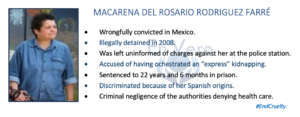In charge of the Héctor Manuel Casique Fernández Case: David Bertet
Case summary
Translation: Jorge B.
Héctor was 28 years old. He used to teach Tae Kwan Do and provide courses to various police forces, and individuals in general. He was incarcerated in Cancún and accused of the murder of 7 people at the bar La Sirenita.
From his testimony, the evidence on file, and the allegations made by his defence attorneys, the following facts emerge:
On Saturday March 16, 2013, Héctor was with his fiancée Karla Yaneth Fuente Pérez, Maximiliano Ezequiel Millán González and Alicia Zaragosa at the Mandala Night Club. Héctor and Maximiliano told the others that they would step out of the club. When they wanted to come back in, they were stopped being told that it was a routine check, taken to the Public Security facilities, checked by a doctor who found they were in perfect condition, taken to the offices and told they were there for assaulting a policeman.
They were placed at the disposal of the Public Prosecutor’s Office of the Common Jurisdiction of the hotel zone, transferred to cells where they stayed for two hours. Héctor was removed from his cell, returned half an hour later and then they were told that they would have to pay a fine for having attacked the policeman. Two hours later the policemen returned and took Héctor to another cell.
Maximiliano said that at that moment they asked him to turn around and kneel, bandaged his wrists and face, and handcuffed him. They then took him to another room where they told him that he had killed seven people, put plastic bags over his head to suffocate him, and threw him to the floor face down. He felt like about three to four people sat on his back. They continued torturing him telling him that even if he had not killed those people he would have to say he had done it. They tortured him until he passed out. He would hear from the other room how they would also torture Héctor, who would ask them to stop beating him and scream out in pain. When he woke up he realized that he was no longer handcuffed. He was tortured again and later taken to a room where Héctor, who had also been tortured, was with a swollen shut eye.
A Federal Police Agent pointing his gun at Héctor told him that he was a member of the navy. Héctor asked for his help because the police were beating him a lot, to which he said he was from the police and hit Héctor in the head with the butt of his pistol, making his forehead bleed. Using his work-based recognition skills, Héctor recognized the police officers that tortured him.
On March 16, he said to have been a victim of rape. About 20 hours of being in a prison cell, he was naked lying on the floor when police officer Wady Alfredo Constantino Solana approached him, put his fingers as well as a device in the rectum while pointing his gun at him and shouting that he plead guilty to the multiple homicides at the bar La Sirenita. They then threatened to kill him and his whole family. Constantino Solana then told him “you bastard,” that’s what happens to those who do not want to talk and confess for their own good, and that he was going to be found guilty anyway. They covered his face with a rag that they had wet with habanero pepper. As a result of the rape he had rectal bleeding that lasted four consecutive days, and as a result of the habanero pepper he couldn’t open his eye for 4 days, losing sight on that eye for two weeks.
On March 17, the Prosecutor together with the Deputy Prosecutor and the Director of the Judicial Police gave a press conference showing Héctor, saying that they had arrested the man behind the murders at the bar La Sirenita and presented him as the actual perpetrator. When the sodium rhodizonate test came out negative, they presented him as the intellectual perpetrator. At first they showed him as “Head of the Zetas” and later as “Head of the Gulf Cartel.”
A formal request was sent to the Director of the Social Reintegration Center for him to take Héctor’s ministerial statement. During the time that the process lasted Héctor continued being tortured. His mother says that they tried to burn him by bathing him in thinner following the director’s orders. They broke his ribs and sent him to the hospital.
On November 15, 2013, the writ of amparo was granted for the purpose of declaring void the arrest warrant of March 28, 2013. An appeal for review was filed, but on February 13, 2014, the writ of amparo judgment was upheld.
On March 10, 2014, Héctor had an order of release of which he was notified at 4 pm; however, the judicial officers (30 of them in pickup trucks and cars) waiting for him at the second check point, stopped him without any arrest warrant, and a new preliminary inquiry was started due to “new implications.” Again, the Public Prosecutor gave a press conference, pointing out at Héctor.
On March 15, 2014, at 11 pm, five judicial officers arrived to take Héctor away but the custodians did not allow it. Due to this situation, Héctor’s family requested he’d be transferred to the Chetumal Center for Social Rehabilitation. On April 11, 2014, Héctor’s mother reported that several officials who participated in his torture had received promotions.
On June 12, the CNDH (National Human Rights Commission) sent the Istanbul Protocol to the CEDH (State Commission on Human Rights), which proved Héctor’s torture, both physical and psychological. On June 25, he was notified of the non-execution of the criminal action against the torturers of the complaint filed by Héctor against these acts and for rape. For this reason an appeal of nonconformity was filed. On July 7, 2014, a writ of amparo trial was filed against the CEDH for lack of response. On August 18, 2014, the Fifth District Court in the state of Quintana Roo granted the amparo for a new decision ordering his release to be issued. The authorities lodged an appeal for review that has yet to be resolved.
On September 26, there was a press conference in Cencos supporting the case. On November 4, 2014, the CEAV (Executive Commission for Victims) decided to review the case, both because of its severity and because Quintana Roo did not yet have a local victim assistance commission. On December 10, the CEAV unanimously decided to recognize Héctor’s victim status.
After years of struggle, the family obtained a sentence in which the Superior Court of Justice ordered to prosecute 35 members of the Attorney General’s Office of the state of Quintana Roo who had participated in Héctor’s torture and rape. Héctor’s imprisonment lasted three years and six months and ended with his release at the end of September 2016. Héctor received a public apology from the current Attorney General’s Office.
On June 8 of this year, Héctor Casique was getting ready for an appearance of recognition of the alleged perpetrators of his torture when he was brutally murdered by two individuals who came to the Las Koras seafood restaurant at the entrance to Cancún, to commit their crime. The family had been afraid that once released Héctor would be arrested and tortured again or the subject of retaliatory actions, given that they had received constant death threats, allegedly from people close to the State Prosecutor.
On June 19, 2017 in a communiqué addressed to public opinion, En Vero expressed its deep indignation at the murder of Mexican citizen Héctor Casique, In a strong and unequivocal way we condemn this vicious murder.




